|
The Royal National Lifeboat Institution (RNLI) is a charity whose aim is to save lives at sea around the coasts of Great Britain and Ireland, as well as inshore. It was founded on 4 March 1824 as the National Institution for the Preservation of Life from Shipwreck, adopting the present name in 1854.
The RNLI operates over 230 lifeboat stations, strategically placed around the coasts of the United Kingdom and Republic of Ireland. Since 1980, lifeboat rescues have doubled; the RNLI rescues an average of 22 people each day.
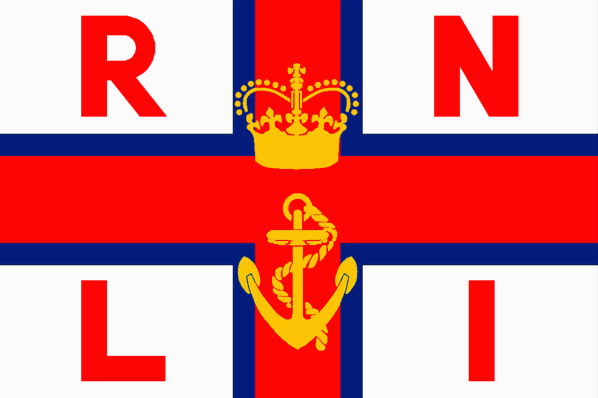
RNLI
flag
The charity also employs lifeguards on beaches in the south west, south Wales and Norfolk. In 2008, this service will be expanded to cover 107
beaches.
The RNLI is funded entirely by voluntary donations and legacies (together with tax reclaims), and has an annual budget of £130m.
Originally many lifeboat crew members came from maritime backgrounds, but with the decline of many maritime industries only one in ten volunteers now has a professional maritime background. Volunteer crews are more likely to be teachers or shop keepers than
fishermen.
2006 was the RNLI's busiest year on record.
The founder, Sir William Hillary
Sir William Hillary came to live on the Isle of Man in 1808. Being aware of the treacherous nature of the Irish Sea, with many ships being wrecked around the Manx coast, he drew up plans for a national lifeboat service manned by trained crews. Initially he received little response from the Admiralty but on appealing to the more philanthropic members of London society, the plans were enthusiastically adopted and the National Institution for the Preservation of Life from Shipwreck was founded in 1824. The title changed 30 years later to the Royal National Lifeboat Institution and the first of the new lifeboats to be built was stationed at Douglas in recognition of the work of Sir William.
At the age of 60, Sir William took part in the rescue, in 1830, of the packet St George, which had foundered on Conister Rock at the entrance to Douglas harbour. He commanded the lifeboat, was washed overboard with others of the lifeboat crew, yet finally everyone aboard the St George was rescued with no loss of life.
It was this incident which prompted Sir William to set up a scheme to build The Tower of Refuge on Conister Rock - a project completed in 1832 which stands to this day at the entrance to Douglas
harbour.
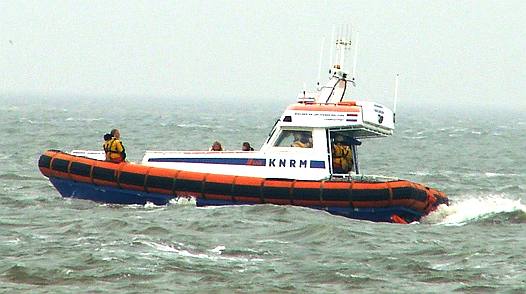
A
lifeboat on sea trials
The RNLI in action
Severn class lifeboat, Poole Harbour, Dorset. This is the largest class of UK lifeboat, at 17 metres longSince the RNLI was founded, its lifeboats have saved over 137,000 lives (as of November
2006).
The RNLI operates five classes of inshore lifeboats, both inflatable boats and RIBs, of 20-40 knots (37-74 km/h), and six classes of all-weather motor life boats with maximum speeds of 16-25 knots (30-46 km/h). It maintains an active fleet of 332 lifeboats based at 233 lifeboat stations. It also has an active fleet of four hovercraft introduced in 2002 allowing rescue in mud flats and river estuaries inaccessible to conventional boats. The crews of the lifeboats are almost entirely volunteers, the 4,600 sea-going crew members, including over 300 women, are alerted by pagers backed up by maroons and attend the lifeboat station when alerted.
The Humber lifeboat station at Spurn Point, East Riding of Yorkshire is one of only two lifeboat stations in the UK which are crewed full time (the other being Waterloo Pier, on the River Thames in London). The crew live in a few houses on Spurn Point which in bad weather can be cut off from the mainland. The other occupants of Spurn Point are Associated British Ports who man their Vessel Traffic Service control tower 24 hours a day 365 days a year along with the lifeboat crew.
In the United Kingdom, ships in distress or the public reporting an accident must contact HM Coastguard on MF radio (frequency 2182 kHz), VHF radio (Channel 16) or by telephoning 999 or 112. In the Republic of Ireland they must contact the Irish Coast Guard, or telephone 112 or 999. The Coastguard co-ordinates rescue at sea and may call on the RNLI (or other lifeboats) or their own land-based rescue personnel or rescue helicopters to take part. Air-Sea rescue helicopters are provided by the Royal Air Force, the Royal Navy, the Marine & Coastguard Agency (HM Coastguard), and the Irish Air Corps.
Classes of lifeboats in service
The RNLI station, at Beaumaris, Anglesey, WalesMain category: Classes of RNLI lifeboats.
The RNLI has two main categories of lifeboat:
All weather boats - Large boats that are capable of high speed in extreme weather conditions and have a large range.
Inshore lifeboats - Smaller boats that operate closer to the shore than all weather boats and are able to operate in shallower waters and closer to cliffs.
Biggest RNLI rescue
The biggest rescue in the RNLI's history was 17 March 1907 when the 12,000 tonne liner SS Suevic hit the Maenheere Reef near Lizard Point in Cornwall. In a strong gale and dense fog RNLI lifeboat volunteers rescued 456 passengers, including 70 babies. Crews from The Lizard, Cadgwith, Coverack and Porthleven rowed out repeatedly for 16 hours to rescue all of the people on board. Six silver RNLI medals were later awarded, two to Suevic crew
members.
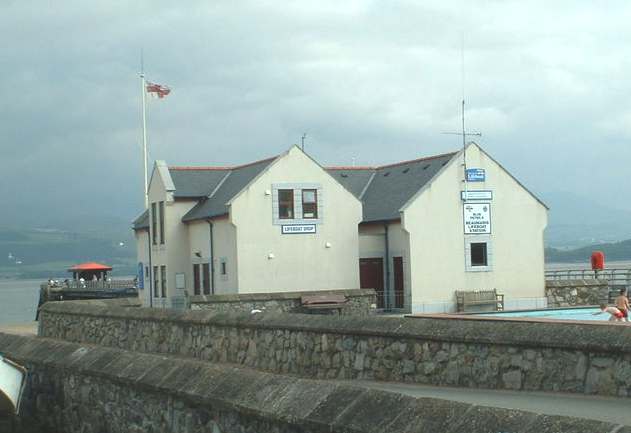
Lifeboat
Station Anglesey
Lifeboat losses
Over the years, many members of boat and launching crews have been killed during or died as a result of lifeboat operations.
1871 - Bridlington lifeboat RNLB Harbinger was lost with six lives in the Great Gale of 1871.
1880 - The Wells-next-the-Sea lifeboat Eliza Adams went to the aid of the stricken brig Ocean Queen in heavy seas. The lifeboat capsized and 11 of her 13 crew were drowned.
1886 - St Anne's, Lytham and Southport lifeboats went to the assistance of a German barque, the Mexico in trouble in heavy seas. The St Anne's and Southport boats were lost with 27 lifeboatmen.
1899 - In one of the RNLI's most legendary feats, the Lynmouth lifeboat Louisa was hauled overland over Exmoor for over 10 hours to Porlock to go to the aid of a ship. On arrival she was launched immediately and stood by the stricken ship until daybreak, when a tug arrived.
1901 - Nine members of the Caister-on-Sea lifeboat were drowned when their lifeboat Beauchamp overturned in heavy seas. Asked why they had persisted in their rescue attempts the retired coxswain said "Caister men never turn back".
1914 - Nine members of the crew of the Fethard-on-Sea lifeboat crew were drowned when their boat capsized. They were attempting to reach the stricken steamer Mexico which was going down off the Co Wexford coast.
1928 - The Rye Harbour lifeboat disaster, in which the Mary Stanford was capsized and 17 men lost their lives.
1947 - 8 crew of the Mumbles lifeboat died attempting to rescue the crew of SS Samtampa off south Wales, on 23 April 1947. A total of 45 lives were lost.
1959 - All 8 crew of the Broughty Ferry lifeboat died while attempting to rescue the North Carr lightship
1962 - After rescuing the five crew members of the Coble Economy on the 17 November, the Seaham lifeboat capsized on its way back to the shore. All five lifeboat crewmen died, only one crewman from the Economy survived.
1981 - The Penlee lifeboat Solomon Browne was lost, with all eight crew, going to the aid of the freighter Union Star. A total of 16 lives were lost - there were no survivors and only 8 bodies were recovered.
Roll of honour
Lifeboat crewmen have been awarded medals for their bravery. One of the most notable is Henry Blogg, of the Cromer lifeboat crew, who was awarded the RNLI gold medal three times. He also received the George Cross and the
British Empire Medal. He is known as "The Greatest of all
Lifeboatmen"
Headquarters
The Lifeboat College, PooleThe headquarters of the RNLI are in Poole, Dorset. The RNLI site is located adjacent to the Holes Bay in Poole Harbour. It includes RNLI HQ, lifeboat maintenance and repair facilities, the Lifeboat Support Centre and the National Training Centre, the Lifeboat College. The support centre and college were opened by Queen Elizabeth II in
2004. Specialist training facilities include a wave and capsize pool, a fire simulator, a bridge simulator and a live engineering
workshop.
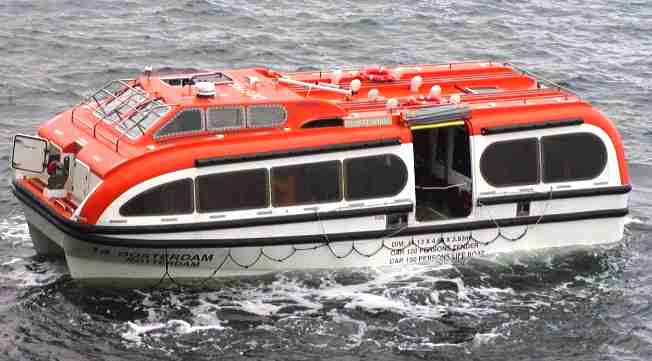
A
catamaran lifeboat tender
LIFEBOATS
A lifeboat is a boat designed to save the lives of people in trouble at sea. This term is predominatly used in the United Kingdom, and may refer to special shore-based vessels manned by volunteers, designed to quickly reach a ship or individuals in trouble at sea. Lifeboats may be rigid or inflatable vessels.
The first boat specialized as a lifeboat was tested on the River Tyne on January 29, 1790. William Wouldhave and Lionel Lukin both claimed to be the inventor of the first lifeboat. One example of an early lifeboat was the Landguard Fort Lifeboat of 1821, designed by Richard Hall Gower.
In U.S. waters, rescue-at-sea is part of the duties of the United States Coast Guard, which employs its multipurpose ships and
aircraft in this role.
Modern life boats
Modern motor life boats (MLB) originated as life boats that had been modified with the addition of an engine and provided more power to get in and out of the swell area inside the surf. They can be launched from shore in any weather and perform rescues further distances out. Older lifeboats relied on sails and oars, which are slower and dependent on wind conditions or manpower. Both types remain in use. All lifeboats of this type generally have modern electronic devices such as radios and radar to help locate the party in distress and carry medical and food supplies for the survivors.
A 47 MLB charges through the surfThe MLB was initially developed by the United States Life Saving Service in 1899, of which models derived from this hull design remained in use until 1987. The United States Life Saving Service later would become the
United States Coast Guard and continue in its original mission of saving lives.
The Royal National Lifeboat Institution (or RNLI) maintains lifeboats around the coasts of the United Kingdom and Republic of Ireland, manned by unpaid volunteers with equipment funded through voluntary donation - web-site at www.rnli.org.uk. Most Scandinavian countries also have volunteer lifeboat societies. The local branch of a society generally schedules practices, maintains a lifeboat and shed, and is contacted by commercial marine radio operators when a rescue is needed.
In Australasia, surf lifesaving clubs operate inflatable rescue boats (IRB) for in-shore rescues of swimmers and surfers. These boats are best typified by the rubber Zodiac and are powered by an outboard motor. The rescue personnel wear wet suits.
The Rigid Hulled Inflatable Boat (RIB) is now seen as the best type of craft for in-shore rescues as they are less likely to be tipped over by the wind or breakers. Specially designed Jet rescue boats have also been used successfully. Unlike ordinary pleasure craft, these small to medium sized rescue craft often have very low freeboard so that victims can be taken aboard without lifting. This means that the boats are designed to operate with water inside the boat hull and rely on flotation tanks rather than hull displacement to stay afloat and upright.
Lifeboat tender of the Oosterdam showing the "face mask" over the front windows, and the rolled-up tarp that can be brought down over the entry port to make the boat watertightThe Dutch lifeboat association (KNRM) has put many efforts in developing jet-driven RIB lifeboats. This has resulted in 3 classes. The largest is the "Arie Visser-class: length 18,80 m, twin jet, 2 x 1000 hp, max. speed 35 kts, capacity 120 persons.
Lifeboats are also operated inland at specific events, organisations such as the Royal Life Saving Society (RLSS UK) provide coverage of rivers, lakes and such like.
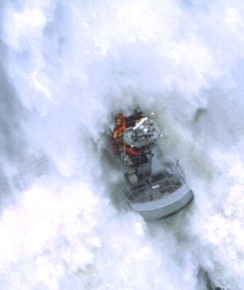
A
lifeboat in heavy surf
Head
Office:
West
Quay Road
Poole
BH15
1HZ
Telephone:
0845 122 6999
Home
Contact
RNLI
Become
a crew member
RNLI
shop
The
Lifeboat College
Lifeguards
Sea
and Beach Safety
Education
Media
Centre
Jobs
Donate
Now
Site
Directory
The
RNLI, a charity registered in England, Scotland and the Republic
of Ireland, charity number 209603,
As with
Solarnavigator, the
RNLI is funded entirely by voluntary donations and legacies. For
the RNLI to continue to save lives at sea they need your
help. In the 30 seconds or so it will take you to read
this sentence, the cost of maintaining the nation's maritime
rescue service will have been over £95 - not a penny of
which comes from the government. A
partnership with the RNLI can offer your company a unique
opportunity to link with one of the most respected charities,
whether you are looking for a local, regional or national
relationship within the United Kingdom and the Republic of
Ireland.
|
Legacies
|
|
Six
out of every ten lifeboat launches are only
possible thanks to legacies.
The RNLI volunteer crews expect no thanks or
reward for the risks they take and the sacrifices
they make. For their safety, the RNLI needs to
ensure that they have up-to-date boats and
equipment both today and in the future.
If
you think you could help with a legacy, please
send for the RNLI's new, free booklet and video.
These useful guides will help give you helpful
information about how to make or update your Will,
as well as how to leave a legacy to the RNLI.
|
 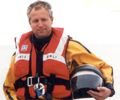
|
|
|
Please
contact John Marshall, Legacy Enquiries Officer on 01202
663032 for more information
|
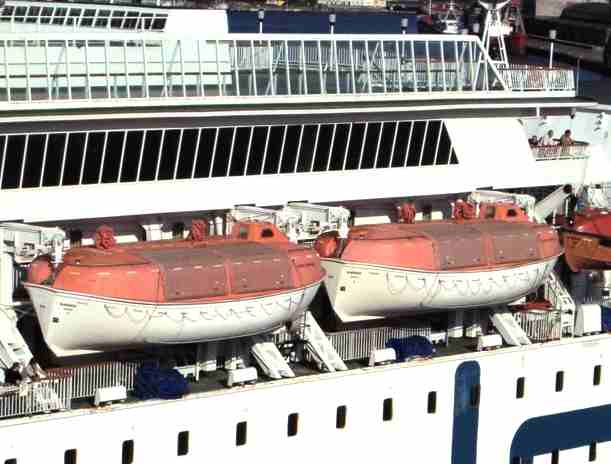
Liner
lifeboats hung on davits
Links:
Solarnavigator.org
(UK) Ltd. is not responsible for the content of external
internet sites
|
Boat
Show 2002 |
|
The
Giving Campaign |
|
http://www.givingcampaign.org.uk/ |
| |
|
Gosport
and Fareham Inshore Rescue |
|
www.hants.gov.uk/gafirs/NEW01/frontpage.html |
| |
|
The
Hyperbaric Medicine Unit, Aberdeen |
|
http://www.hyperchamber.com/ |
| |
|
Maritime
and Coastguard Agency |
|
www.mcagency.org.uk/ |
| |
|
National
Coastwatch Institution |
|
http://www.nci.org.uk/ |
| |
|
National
Maritime Museum Research Engine |
|
http://www.port.nmm.ac.uk/ |
| |
|
SNSM,
France's maritime rescue service |
|
www.snsm.eu.org/ |
| |
|
Zetland
Museum |
|
http://www.zetland200.com/ |
| |
|
http://www.pianc-aipcn.org |
|
International
Navigation Association |
| |
|
AFRAS |
|
http://www.afras.org/ |
| |
|
E P
Barrus - Engine Suppliers to the RNLI |
|
http://www.barrus.co.uk/ |
| |
|
Canadian
Coastguard Auxiliary |
|
http://www.ccga-gcac.com/ |
| |
|
USCGA,
US Coast Guard Auxiliary |
|
http://www.cgaux.org/ |
| |
|
Cowes
Inshore Lifeboat |
|
http://www.cowesinshorelifeboat.org.uk/ |
| |
|
DGzRS
Germany's maritime rescue service |
|
http://www.dgzrs.de/ |
| |
|
KNRM,
The Netherland's maritime rescue service |
|
http://www.knrm.nl/ |
| |
|
ICE-SAR,
Iceland's maritime rescue service |
|
http://www.landsbjorg.is/ |
| |
|
The
International Lifeboat Federation's web site |
|
http://www.lifeboats.org/ |
| |
|
SM,
Finland's Lifeboat Service |
|
http://www.meripelastus.fi/ |
| |
|
Canadian
Lifeboat institution |
|
www.netlink2000.com/lifeboat |
| |
|
NSRI,
South Africa's maritime rescue service |
|
http://www.nsri.org.za/ |
| |
|
NSSR,
Norway's maritime rescue service |
|
http://www.nssr.no/ |
| |
|
SNS,
Italy's maritime rescue service |
|
http://www.sns.it/ |
|
|
SSRS,
Sweden's maritime rescue service |
|
http://www.ssrs.se/ |
| |
|
US
Coastguard |
|
http://www.uscg.mil/ |
| |
|
VISAR
The Virgin Island's maritime rescue service |
|
http://www.visar.org/ |
| |
|
Diving |
|
The
Hyperbaric Medicine Unit, Aberdeen |
|
http://www.hyperchamber.com/ |
| |
|
The
award winning newspaper of the Royal Navy |
|
www.navynews.co.uk/ |
| |
|
The
RNLI's official maritime leisure insurance co |
|
http://www.bishopskinner.com/ |
| |
|
Weather
buoys |
|
www.ems.psu.edu/wx/regions/all.html |
| |
|
European
Weather |
|
http://www.euroweather.net/ |
| |
|
Weather |
|
http://www.metoffice.com/ |
| |
|
Weather
satellite pictures |
|
www.sat.dundee.ac.uk/pdus.html |
| |
|
Jet
Ski |
|
The
award winning newspaper of the Royal Navy |
|
www.navynews.co.uk/ |
| |
|
Weather
buoys |
|
www.ems.psu.edu/wx/regions/all.html |
| |
|
European
Weather |
|
http://www.euroweather.net/ |
| |
|
Weather |
|
http://www.metoffice.com/ |
| |
|
Weather
satellite pictures |
|
www.sat.dundee.ac.uk/pdus.html |
| |
|
Kitesurfing |
|
The
award winning newspaper of the Royal Navy |
|
www.navynews.co.uk/ |
| |
|
The
RNLI's official maritime leisure insurance co |
|
http://www.bishopskinner.com/ |
| |
|
Weather
buoys |
|
www.ems.psu.edu/wx/regions/all.html |
| |
|
European
Weather |
|
http://www.euroweather.net/ |
| |
|
Weather |
|
http://www.metoffice.com/ |
| |
|
Weather
satellite pictures |
|
www.sat.dundee.ac.uk/pdus.html |
| |
|
Motor
& Power Boats |
|
The
award winning newspaper of the Royal Navy |
|
www.navynews.co.uk/ |
| |
|
The
RNLI's official maritime leisure insurance co |
|
http://www.bishopskinner.com/ |
| |
|
Weather
buoys |
|
www.ems.psu.edu/wx/regions/all.html |
| |
|
European
Weather |
|
http://www.euroweather.net/ |
| |
|
Weather |
|
http://www.metoffice.com/ |
| |
|
Weather
satellite pictures |
|
www.sat.dundee.ac.uk/pdus.html |
| |
|
Sailing |
|
The
award winning newspaper of the Royal Navy |
|
www.navynews.co.uk/ |
| |
|
The
RNLI's official maritime leisure insurance co |
|
http://www.bishopskinner.com/ |
| |
|
BT
Challenge |
|
http://www.btchallenge.com/ |
| |
|
Weather
buoys |
|
www.ems.psu.edu/wx/regions/all.html |
| |
|
European
Weather |
|
http://www.euroweather.net/ |
| |
|
Fairey
Owner's Club |
|
http://www.faireyownersclub.co.uk/ |
| |
|
Weather |
|
http://www.metoffice.com/ |
| |
|
Weather
satellite pictures |
|
www.sat.dundee.ac.uk/pdus.html |
| |
|
Sea
Angling |
|
The
award winning newspaper of the Royal Navy |
|
www.navynews.co.uk/ |
| |
|
The
RNLI's official maritime leisure insurance co |
|
http://www.bishopskinner.com/ |
| |
|
Weather
buoys |
|
www.ems.psu.edu/wx/regions/all.html |
| |
|
European
Weather |
|
http://www.euroweather.net/ |
|
|
Weather |
|
http://www.metoffice.com/ |
| |
|
Weather
satellite pictures |
|
www.sat.dundee.ac.uk/pdus.html |
| |
|
Windsurfing |
|
The
award winning newspaper of the Royal Navy |
|
www.navynews.co.uk/ |
| |
|
The
RNLI's official maritime leisure insurance co |
|
http://www.bishopskinner.com/ |
| |
|
Weather
buoys |
|
www.ems.psu.edu/wx/regions/all.html |
| |
|
European
Weather |
|
http://www.euroweather.net/ |
|
|
Weather |
|
http://www.metoffice.com/ |
| |
|
Weather
satellite pictures |
|
www.sat.dundee.ac.uk/pdus.html |
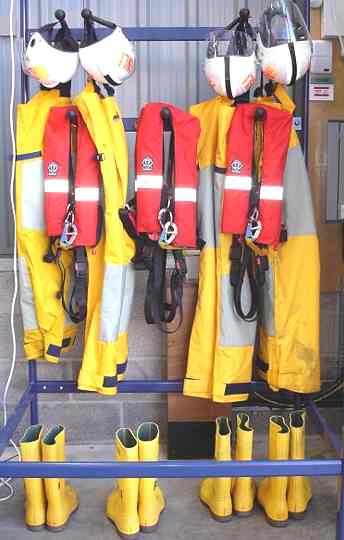

New
energy drinks for performers
..
Thirst for Life

330ml
Earth can - the World in Your Hands
|










